Papers by Claudia K B Oshiro
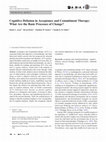
Acceptance and commitment therapy (ACT) is a contextual–behavioral approach to psychotherapy and ... more Acceptance and commitment therapy (ACT) is a contextual–behavioral approach to psychotherapy and other behavioral health concerns that has progressively attracted attention from both researchers and clinicians. ACT's psychological flexibility model relies on middle-level terms that, despite being less precise than behavioral principles, are seen as being valuable for teaching and practicing ACT. One such term is cognitive defusion, which refers to the reduction of stimulus function transformation that occurs through verbal relations. In other words, defusion aims to minimize the influence of verbal relations, such as thoughts, on behavior, when doing so leads to adaptive behavior and valued living. Recently, some authors have stressed the importance of functionally defining middle-level terms, establishing clear links between the concept and basic behavioral processes. This article begins this endeavor by analyzing these links with respect to cognitive defusion. First, we briefly contextualize ACT's theoretical roots. Second, we present cognitive defusion as a therapeutic intervention, reviewing its objectives , procedures, outcomes, and hypothesized processes as stated in the relevant literature. Third, the outlined process of change is critically examined, leading to a new conceptualiza-tion of cognitive defusion. Finally, the conceptual, clinical, and research implications of this new conceptualization are considered.
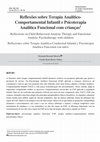
RESUMO A literatura sobre terapia comportamental infantil denuncia carência em pesquisas aplicada... more RESUMO A literatura sobre terapia comportamental infantil denuncia carência em pesquisas aplicadas que guiem a prestação de serviço. Na Psicoterapia Analítica Funcional (FAP) aplicada a crianças, observa-se tal constatação e nota-se que essa proposta tem sido utilizada como uma técnica adjunta à Terapia Analítico-Comportamental Infantil (TACI) e com pouca sistematização dos procedimentos. Nesse sentido, julga-se importante compreender melhor os processos comportamentais envolvidos na FAP aplicada à população infantil. Para tal, foi realizada uma primeira reflexão por meio de uma comparação entre TACI e FAP com crianças, tomando como base artigos dos principais pesquisadores clínicos brasileiros. As seguintes categorias foram criadas para análise: papel do vínculo terapêutico, tipo de reforço utilizado, forma de utilização das regras da FAP, objetivos da terapia e foco da intervenção. Observou-se que ambas as propostas compartilham elementos e procedimentos, tais como o uso de reforço arbitrário e natural, a relação terapêutica como instrumento de mudança e o uso sistemático ou não das regras da FAP. A diferença importante está na sistematização do uso das cinco regras da FAP nesse tipo de terapia, algo pouco seguido na TACI.
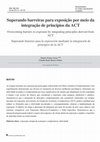
RESUMO As terapias baseadas em exposição possuem papel central dentro da Clínica Analítico-Compor... more RESUMO As terapias baseadas em exposição possuem papel central dentro da Clínica Analítico-Comportamental e têm repetidamente demonstrado sua eficácia no tratamento de diversos problemas psicológicos. Entretanto sua efetividade na prática é comprometida por taxas significativas de clientes que abandonam ou não respondem à terapia e por receios de clínicos que consideram a exposição como perigosa, intolerável e antiética. Argumenta-se que a integração de princípios comportamentais não usualmente enfatizados nas terapias baseadas em exposição, provenientes da Terapia de Aceitação e Compromisso (ACT), podem contribuir para reduzir os obstáculos para a efetividade encontrados e, consequentemente, otimizar a implementação da exposição. O objetivo do artigo é apresentar tal integração por meio de recortes de dois casos clínicos com sintomas compatíveis com Transtorno Obsessivo-Compulsivo e Fobia Específica. Demonstra-se que a integração proposta pode reduzir a esquiva do terapeuta e do cliente diante da exposição e ampliar o repertório do indivíduo frente ao evento temido. Palavras-chave: exposição; terapia de aceitação e compromisso; efetividade.
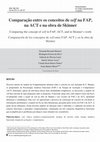
Several behavioral analysts have extensively debated about the self, including B. F. Skinner and ... more Several behavioral analysts have extensively debated about the self, including B. F. Skinner and the
proponents of the Functional Analytic Psychotherapy (FAP) and Acceptance and Commitment Therapy
(ACT). Despite the current relevance of these two psychotherapies, their discussions regarding the self lacks
integration. This paper aims to present a brief assessment of the similarities and differences regarding the
concept of self in Skinner’s work, FAP and ACT literature. To do so, this paper reviews the construction
process of the concept of self, starting from preliminary formulations in Skinner’s work and working its way
through FAP’s and ACT’s texts. Stemming from these definitions, interaction patterns between the
individual and the environment are described in terms of functional relations and basic behavioral principles,
resulting in three functional diagnostic categories that exemplifies the psychological issues most reported in
clinical practice.
ReSuMO A Ciência do Comportamento pode utilizar termos do cotidiano para entender e intervir sobr... more ReSuMO A Ciência do Comportamento pode utilizar termos do cotidiano para entender e intervir sobre o mundo desde que estes sejam operacionalizados em uma conceituação comportamental. A discussão sobre " valores " vem sendo abordada por autores da área ligados à pesquisa teórica e à prática clínica. Nesse sentido, enquanto elemento que passa a embasar a prática do analista do comportamento, faz-se relevante a sua compreensão relacionando-a ao corpo de conhecimento construído nessa abordagem. Assim, utilizando-se da literatura da Análise do Comportamento, especificamente o comportamento verbal, as contingências de reforçamento sociais e o comportamento simbólico, o objetivo do presente artigo é investigar o desenvolvimento conceitual do termo " valores " e algumas das implicações para a prática do terapeuta analítico-comportamental.
Aos meus pais, Kenji e Fátima, que me ensinaram a ser curiosa, a questionar todas as coisas do mu... more Aos meus pais, Kenji e Fátima, que me ensinaram a ser curiosa, a questionar todas as coisas do mundo e a não me contentar com uma simples resposta. Obrigada pelo apoio incondicional na trajetória de minha vida. E como eles sempre falam: "Filhos é para a vida toda!". À minha querida orientadora Sonia Meyer, que me acolheu de braços abertos na chegada a São Paulo em 2006, depois de uma grande mudança na minha vida.

Functional Analytic Psychotherapy (FAP) was created in the late eighties by Kohlenberg and Tsai a... more Functional Analytic Psychotherapy (FAP) was created in the late eighties by Kohlenberg and Tsai as an attempt to explain, in behavioral-analytic terms, the therapeutic interaction as an instrument to promote behavioral changes. Currently, this kind of psychotherapy is obtaining empirical validation and is emerging as an effective psychotherapy for difficult clinical cases, which are usually those with some kind of difficulty in interpersonal relationships. However, there are just a few researches that show the variables of the therapeutic process, that is, variables of the client and therapist who favor and/or hinder the progress of therapy and the processes and procedures responsible for behavioral change. The present study aimed to evaluate the effects of the introduction and withdrawal of FAP interventions on the following categories created from the researcher’s clinical observations of some behaviors in session (clinically relevant behaviors, CRBs) that were affecting the progr...
Artigo derivado da dissertação de mestrado da primeira autora, sob orientação da segunda, defendi... more Artigo derivado da dissertação de mestrado da primeira autora, sob orientação da segunda, defendida no Programa de Pós-Graduação em Educação Especial da Universidade Federal de São Carlos. A pesquisa foi apoiada por auxílio da FAPESP/PRONEX (Processo # 03/009928-4) e FAPESP #00/ 04277-7. As autoras agradecem as muitas contribuições de Júlio C. de Rose ao longo de todo o projeto; agradecem também a dois pareceristas anônimos, cujas revisões cuidadosas permitiram o aperfeiçoamento do texto. Endereço para correspondência: Deisy G.
The present article describes and analyzes educational experiences related to the teaching of FAP... more The present article describes and analyzes educational experiences related to the teaching of FAP for psychology graduate students and psychiatry residents at the University of São Paulo. The first experience involved psychology graduate students and includes an example of the shaping process occurring within the supervisor-supervisee relationship, the changes observed in the supervisees´repertories and the impact this had in the way they would conduct therapy. The second experience involved Psychiatry residents
training that involved a role-playing procedure to present the five rules of FAP and shape therapist’s relevant behaviors, as well as the adoption of a specific FAP based intervention to modify the supervisees’ behavior during supervision and with the client.
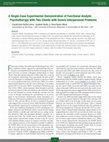
F unctional Analytic Psychotherapy (Kohlenberg & Tsai, 1991) is a behavior analytic approach to p... more F unctional Analytic Psychotherapy (Kohlenberg & Tsai, 1991) is a behavior analytic approach to psychotherapy that em-phasizes as its hypothesized mechanism of change the thera-pist's provision of natural contingent reinforcement to shape clients' clinically relevant behaviors (CRBs) when they occur in the therapeutic relationship. More specifically, the goal of FAP is for the therapist to contingently respond to decrease CRB1s (in-session problem behaviors) and increase CRB2s (in-session improvement behaviors) over the course of therapy. A secondary goal in FAP is to increase CRB3s. According to Kohlenberg and Tsai (1991), CRB3s, which represent client attempts to provide functional analyses of their own behavior that should be shaped by the FAP therapist in session, should also increase over the course of therapy, facilitating the generalization of in-session gains to out-of-session environments. Many descriptive case studies on FAP have been published since Kohlenberg and...
Os conceitos de causalidade múltipla, de autoclíticos e de edição podem auxiliar o terapeuta anal... more Os conceitos de causalidade múltipla, de autoclíticos e de edição podem auxiliar o terapeuta analíticocomportamental a conduzir avaliações funcionais e a intervir. Ao avaliar, ele leva em consideração que o conteúdo das falas de clientes tem múltipla determinação e presta atenção a sutilezas de autoclíticos e de edições. Usa autoclíticos para promover bom relacionamento e adesão à terapia e para ensinar o cliente a descrever seu comportamento e controles. Respaldado na noção de causalidade múltipla, pode trabalhar com metáforas, fantasias e alegorias, e pode fornecer estimulação suplementar para fortalecer respostas do cliente já existentes, porém fracas. Discute-se que a lógica do trabalho clínico é diferente do da análise experimental do comportamento e que diferentes análises de comportamento podem ser apropriadas para se alcançar objetivos terapêuticos.






Uploads
Papers by Claudia K B Oshiro
proponents of the Functional Analytic Psychotherapy (FAP) and Acceptance and Commitment Therapy
(ACT). Despite the current relevance of these two psychotherapies, their discussions regarding the self lacks
integration. This paper aims to present a brief assessment of the similarities and differences regarding the
concept of self in Skinner’s work, FAP and ACT literature. To do so, this paper reviews the construction
process of the concept of self, starting from preliminary formulations in Skinner’s work and working its way
through FAP’s and ACT’s texts. Stemming from these definitions, interaction patterns between the
individual and the environment are described in terms of functional relations and basic behavioral principles,
resulting in three functional diagnostic categories that exemplifies the psychological issues most reported in
clinical practice.
training that involved a role-playing procedure to present the five rules of FAP and shape therapist’s relevant behaviors, as well as the adoption of a specific FAP based intervention to modify the supervisees’ behavior during supervision and with the client.
proponents of the Functional Analytic Psychotherapy (FAP) and Acceptance and Commitment Therapy
(ACT). Despite the current relevance of these two psychotherapies, their discussions regarding the self lacks
integration. This paper aims to present a brief assessment of the similarities and differences regarding the
concept of self in Skinner’s work, FAP and ACT literature. To do so, this paper reviews the construction
process of the concept of self, starting from preliminary formulations in Skinner’s work and working its way
through FAP’s and ACT’s texts. Stemming from these definitions, interaction patterns between the
individual and the environment are described in terms of functional relations and basic behavioral principles,
resulting in three functional diagnostic categories that exemplifies the psychological issues most reported in
clinical practice.
training that involved a role-playing procedure to present the five rules of FAP and shape therapist’s relevant behaviors, as well as the adoption of a specific FAP based intervention to modify the supervisees’ behavior during supervision and with the client.